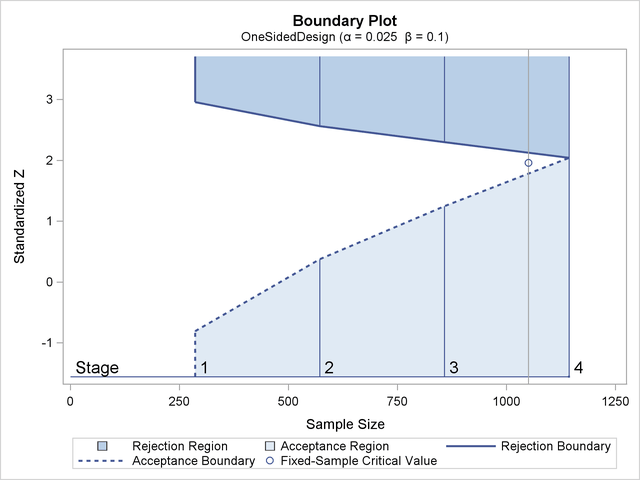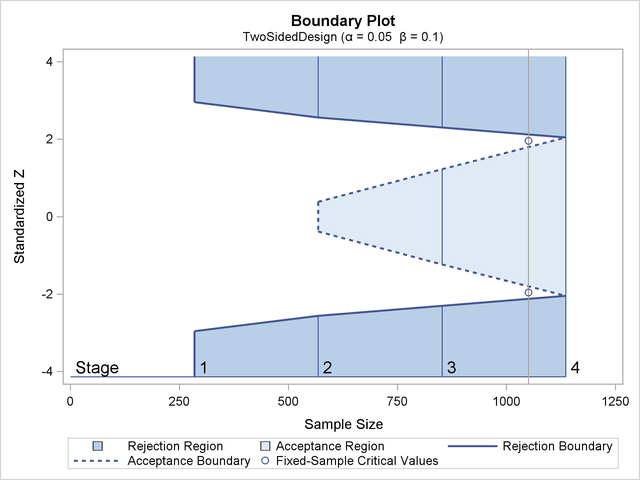The SEQDESIGN Procedure
-
Overview

- Getting Started
-
Syntax

-
Details
 Fixed-Sample Clinical TrialsOne-Sided Fixed-Sample Tests in Clinical TrialsTwo-Sided Fixed-Sample Tests in Clinical TrialsGroup Sequential MethodsStatistical Assumptions for Group Sequential DesignsBoundary ScalesBoundary VariablesType I and Type II ErrorsUnified Family MethodsHaybittle-Peto MethodWhitehead MethodsError Spending MethodsAcceptance (beta) BoundaryBoundary Adjustments for Overlapping Lower and Upper beta BoundariesSpecified and Derived ParametersApplicable Boundary KeysSample Size ComputationApplicable One-Sample Tests and Sample Size ComputationApplicable Two-Sample Tests and Sample Size ComputationApplicable Regression Parameter Tests and Sample Size ComputationAspects of Group Sequential DesignsSummary of Methods in Group Sequential DesignsTable OutputODS Table NamesGraphics OutputODS Graphics
Fixed-Sample Clinical TrialsOne-Sided Fixed-Sample Tests in Clinical TrialsTwo-Sided Fixed-Sample Tests in Clinical TrialsGroup Sequential MethodsStatistical Assumptions for Group Sequential DesignsBoundary ScalesBoundary VariablesType I and Type II ErrorsUnified Family MethodsHaybittle-Peto MethodWhitehead MethodsError Spending MethodsAcceptance (beta) BoundaryBoundary Adjustments for Overlapping Lower and Upper beta BoundariesSpecified and Derived ParametersApplicable Boundary KeysSample Size ComputationApplicable One-Sample Tests and Sample Size ComputationApplicable Two-Sample Tests and Sample Size ComputationApplicable Regression Parameter Tests and Sample Size ComputationAspects of Group Sequential DesignsSummary of Methods in Group Sequential DesignsTable OutputODS Table NamesGraphics OutputODS Graphics -
Examples
 Creating Fixed-Sample DesignsCreating a One-Sided O’Brien-Fleming DesignCreating Two-Sided Pocock and O’Brien-Fleming DesignsGenerating Graphics Display for Sequential DesignsCreating Designs Using Haybittle-Peto MethodsCreating Designs with Various Stopping CriteriaCreating Whitehead’s Triangular DesignsCreating a One-Sided Error Spending DesignCreating Designs with Various Number of StagesCreating Two-Sided Error Spending Designs with and without Overlapping Lower and Upper beta BoundariesCreating a Two-Sided Asymmetric Error Spending Design with Early Stopping to Reject H0Creating a Two-Sided Asymmetric Error Spending Design with Early Stopping to Reject or Accept H0Creating a Design with a Nonbinding Beta BoundaryComputing Sample Size for Survival Data That Have Uniform AccrualComputing Sample Size for Survival Data with Truncated Exponential Accrual
Creating Fixed-Sample DesignsCreating a One-Sided O’Brien-Fleming DesignCreating Two-Sided Pocock and O’Brien-Fleming DesignsGenerating Graphics Display for Sequential DesignsCreating Designs Using Haybittle-Peto MethodsCreating Designs with Various Stopping CriteriaCreating Whitehead’s Triangular DesignsCreating a One-Sided Error Spending DesignCreating Designs with Various Number of StagesCreating Two-Sided Error Spending Designs with and without Overlapping Lower and Upper beta BoundariesCreating a Two-Sided Asymmetric Error Spending Design with Early Stopping to Reject H0Creating a Two-Sided Asymmetric Error Spending Design with Early Stopping to Reject or Accept H0Creating a Design with a Nonbinding Beta BoundaryComputing Sample Size for Survival Data That Have Uniform AccrualComputing Sample Size for Survival Data with Truncated Exponential Accrual - References
The boundaries created in group sequential trials depend on the type of the alternative hypothesis and the early stopping criterion. Table 89.5 shows the boundaries created with various design specifications.
Table 89.5: Boundary Variables
|
Specifications |
Boundary Variables |
||||||
|---|---|---|---|---|---|---|---|
|
Alternative |
Lower |
Upper |
|||||
|
Hypothesis |
Early Stopping |
|
Alpha |
Beta |
|
Beta |
Alpha |
|
Lower |
Accept |
X |
|||||
|
Reject |
X |
||||||
|
Accept/Reject |
X |
X |
|||||
|
Upper |
Accept |
X |
|||||
|
Reject |
X |
||||||
|
Accept/Reject |
X |
X |
|||||
|
Two-sided |
Accept |
X |
X |
||||
|
Reject |
X |
X |
|||||
|
Accept/Reject |
X |
X |
X |
X |
|||
Up to four boundaries can be generated in a group sequential design:
-
the upper
 boundary, to reject the null hypothesis for the upper alternative
boundary, to reject the null hypothesis for the upper alternative
-
the upper
 boundary, to accept the null hypothesis with an upper alternative
boundary, to accept the null hypothesis with an upper alternative
-
the lower
 boundary, to accept the null hypothesis with a lower alternative
boundary, to accept the null hypothesis with a lower alternative
-
the lower
 boundary, to reject the null hypothesis for the lower alternative
boundary, to reject the null hypothesis for the lower alternative
For a two-sided design, the null hypothesis is accepted only if both the hypothesis is accepted with an upper alternative and the hypothesis is accepted with a lower alternative.
For a one-sided design with a lower alternative, only the lower boundaries are created. Similarly, for a one-sided design with an upper alternative, only the upper boundaries are created. For example, Figure 89.10 shows the boundary plot for a one-sided test with an upper alternative.
Figure 89.10 corresponds to a one-sided sequential design with early stopping to reject or accept the null hypothesis. For a sequential test with early stopping only to reject the null hypothesis, there are no acceptance boundary values at interim stages. The acceptance boundary value and its associated acceptance region are displayed only at the final stage. Similarly, for a sequential test with early stopping only to accept the null hypothesis, there are no rejection boundary values at interim stages. The rejection boundary value and its associated rejection region are displayed only at the final stage.
For a two-sided design, both the lower and upper boundaries are created. For a design with early stopping to reject the null
hypothesis, ![]() boundaries are created. Similarly, for a design with early stopping to accept the null hypothesis,
boundaries are created. Similarly, for a design with early stopping to accept the null hypothesis, ![]() boundaries are created. For a design with early stopping to accept or reject the null hypothesis, both the
boundaries are created. For a design with early stopping to accept or reject the null hypothesis, both the ![]() and
and ![]() boundaries are created.
boundaries are created.
For example, Figure 89.11 shows the boundary plot for a two-sided test.
Figure 89.11 corresponds to a two-sided sequential design with early stopping to reject or accept the null hypothesis. For a sequential test with early stopping only to reject the null hypothesis, there are no acceptance boundary values at interim stages. The acceptance boundary value and its associated acceptance region are displayed only at the final stage. Similarly, for a sequential test with early stopping only to accept the null hypothesis, there are no rejection boundary values at interim stages. The rejection boundary value and its associated rejection region are displayed only at the final stage.

